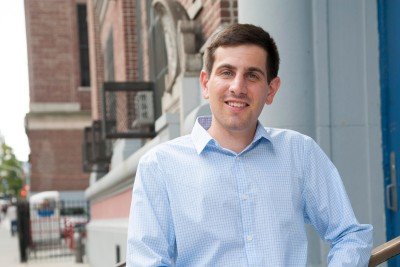Eric's Story
Pheochromocytomas are rare tumors of the adrenal gland. While many are noncancerous, Eric Reingold’s tumor was among those that aren’t. Seeking the best care for a complicated operation, Eric came to Memorial Sloan Kettering, where surgeons successfully removed the tumor. Today, the high school social studies teacher is thrilled to be back in the classroom.

Eric Reingold seemed to have boundless energy. The New Jersey high school social studies teacher spent his time off volunteering for nonprofit organizations and pursuing a doctorate in educational leadership. His enthusiasm and dedication earned him his school’s Teacher of the Year award in 2013.
But at age 27 he discovered one explanation for why he was never able to slow down and relax: He had a pheochromocytoma, a tumor in his adrenal gland that produced excessive amounts of adrenaline (norepinephrine and epinephrine).
Known as the fight-or-flight hormone, the adrenaline had supercharged his energy levels but also put his body into a continuous state of high alert that, among other hazards, was causing life-threatening high blood pressure.
“I thought it was because of my type-A personality that I was always on the go, volunteering for all kinds of causes, involved with local government, and at the same time pursuing advanced degrees,” Eric says. “I was able to channel all of that energy from the adrenaline into a lot of positive things. But in the months before I was diagnosed, I had trouble sleeping. All the adrenaline had started to get to me, and I wasn’t feeling well.”
The Slippery Symptoms of Pheochromocytoma
Symptoms of pheochromocytoma can include high blood pressure, a rapid heartbeat, chest pain or pressure, profuse sweating or flushing, severe headaches, anxiety, and abdominal pain.
But symptoms also vary among individuals and can come and go for years, says Memorial Sloan Kettering surgical oncologist Vivian Strong, who specializes in minimally invasive surgery to remove adrenal gland and gastric tumors. “Some people end up being sent to a psychiatrist because they are told the symptoms are related to stress,” she says.
For Eric, the journey to an accurate diagnosis started when he was 22 years old. Over the course of six years, he saw various doctors for bouts of chest and abdominal pain and several months of unrelenting headaches that no medicine could relieve. Gradually each symptom would subside on its own.
In 2014, a week before he was to don his cap and gown and receive his doctorate diploma, the abdominal pain returned. He was also urinating frequently and having trouble swallowing.
Knowing he needed to get an answer once and for all, he locked up his classroom, unsure when — or if — he’d be back.
Seeking Definitive Answers
The urologist he turned to in desperation ordered an ultrasound that showed a large tumor in one of his adrenal glands, the endocrine glands located above each kidney. “The urologist strongly suspected it was a pheochromocytoma,” Eric says. “I’d never heard of it.”
An online search for pheochromocytoma experts led him to Dr. Strong, a surgeon with years of experience in removing these tumors. She confirmed the urologist’s diagnosis and convened a team of physicians to plot a course of action for Eric. The team included nuclear medicine expert Jorge Carrasquillo and medical oncologist Diane Reidy-Lagunes.
But before the mass could be removed, the doctors first needed to lower Eric’s dangerously high blood pressure. They used specialized medications to relax his constricted blood vessels. “Dr. Strong was so reassuring,” Eric recalls. “I could tell that she genuinely cared about my well-being. She was also very confident she could help me.”
Additional imaging tests showed that the tumor had invaded Eric’s kidney and that he had small metastases in several bones, which means the cancer had begun to spread. In a three-hour surgery, Dr. Strong and her team removed an adrenal gland, the left kidney, and several lymph nodes.
“It’s a delicate and complicated operation, because if at any point you accidentally break into the tumor and spill the tumor cells into the abdomen, it can cause long-term effects that may even be life-threatening,” Dr. Strong explains. “In Eric’s case, the surgery went very well and the entire tumor was removed intact.”
On an Even Keel with Ongoing Treatment
Since the surgery, Eric’s remaining kidney and adrenal gland have begun to take over for the ones that were removed. To slow down damage from the bone metastases, he receives injections of bone-boosting drugs called bisphosphonates.
He’s also treated with MIBG (metaiodobenzylguanidine), a compound that when armed with radioactive iodine delivers targeted, cancer-destroying radiation to metastases wherever they lurk, Dr. Carrasquillo explains.
While MIBG can be a very effective treatment with minor side effects, only two-thirds of pheochromocytoma tumors have the receptors to absorb it. Eric’s tumor cells did. “I was in the room with my brother when they did the test to see if my cells would absorb it,” Eric recounts. “I could see the screen light up, which meant the MIBG was being absorbed. It was amazing.”
Slowing Down, Finally
Without so much adrenaline coursing through his body, Eric has found he finally knows what it feels like to truly relax — though he’s not slowing down too much.
In the two months after the operation, he attended his students’ high school graduation, took a trip to the Caribbean, and went on an overnight hiking trip in the Appalachian Mountains. His professors at Rowan University held a special ceremony to make up for the one that Eric missed, so that he could receive his doctorate diploma.
On a morning in late August, he unlocked his classroom to get it ready for the new school year. “It feels incredible to think how far I’ve come,” Eric says. “I was worried I would never return to teaching, and now I’m back doing what I love.”

